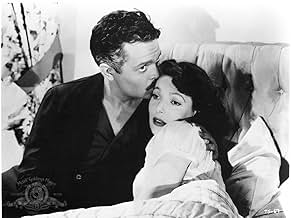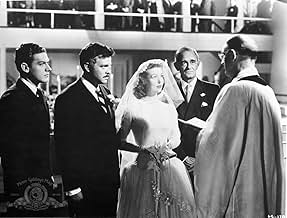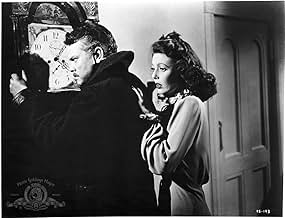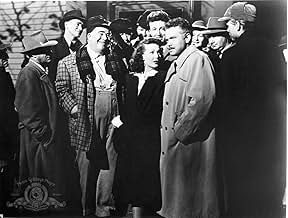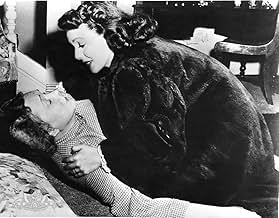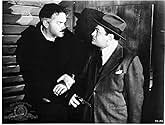IMDb-BEWERTUNG
7,3/10
30.082
IHRE BEWERTUNG
Ein Ermittler der War Crimes Commission reist nach Connecticut, um einen berüchtigten Nazi zu finden.Ein Ermittler der War Crimes Commission reist nach Connecticut, um einen berüchtigten Nazi zu finden.Ein Ermittler der War Crimes Commission reist nach Connecticut, um einen berüchtigten Nazi zu finden.
- Für 1 Oscar nominiert
- 2 Nominierungen insgesamt
David Bond
- Student
- (Nicht genannt)
John Brown
- Passport Photographer
- (Nicht genannt)
Nancy Evans
- Undetermined Role
- (Nicht genannt)
Adolph Faylauer
- War Crimes Commision Member
- (Nicht genannt)
Fred Godoy
- Undetermined Role
- (Nicht genannt)
Theodore Gottlieb
- Fairbright
- (Nicht genannt)
Joseph Granby
- Undetermined Role
- (Nicht genannt)
Ethan Laidlaw
- Todd
- (Nicht genannt)
Empfohlene Bewertungen
It's quite interesting to see two acting legends like Orson Welles and Edward G. Robinson working together, and with a cast that includes those two plus Loretta Young, along with an interesting story, "The Stranger" is a pretty good thriller.
Welles and Robinson play an interesting cat-and-mouse game in the search for a former Nazi who is hiding out in a peaceful Connecticut town. It's fair to point out, as others have done, that the dialogue at times leaves a little to be desired, but Welles and Robinson have more than enough ability to carry it off anyway.
Loretta Young has a difficult role as the wife of Welles's character. The script does her no favors, either, but she gives a creditable performance as a character who is important to the story. Among the supporting cast, Billy House particularly stands out, getting surprisingly good mileage out of his role as the store-keeper.
Perhaps the most creative aspect of the movie is the effective use of the clock tower, both as a plot device and as an idea, along with the related themes of clocks and time. The tense climax makes good use of all of these elements.
Welles and Robinson were both parts of so many outstanding movies that sometimes their merely good movies can seem to suffer by comparison. As long as you don't try to compare "The Stranger" with some other film, but just watch it for itself, it's a good thriller and an entertaining movie.
Welles and Robinson play an interesting cat-and-mouse game in the search for a former Nazi who is hiding out in a peaceful Connecticut town. It's fair to point out, as others have done, that the dialogue at times leaves a little to be desired, but Welles and Robinson have more than enough ability to carry it off anyway.
Loretta Young has a difficult role as the wife of Welles's character. The script does her no favors, either, but she gives a creditable performance as a character who is important to the story. Among the supporting cast, Billy House particularly stands out, getting surprisingly good mileage out of his role as the store-keeper.
Perhaps the most creative aspect of the movie is the effective use of the clock tower, both as a plot device and as an idea, along with the related themes of clocks and time. The tense climax makes good use of all of these elements.
Welles and Robinson were both parts of so many outstanding movies that sometimes their merely good movies can seem to suffer by comparison. As long as you don't try to compare "The Stranger" with some other film, but just watch it for itself, it's a good thriller and an entertaining movie.
Infamous Nazi war criminal called Franz Kindler (Orson Welles) assumes a new respectable identity in a Midwestern little town following WWII , unaware that a government agent (Edward G. Robinson) from the Allied War Crimes commission patiently stalks him . But his name is fake and his past is tenebrous . The escaped Nazi sedately living and is about to marry a beautiful as well as unsuspecting young woman (Loretta Young) , daughter of a prestigious judge (Philip Merivale) . But later on , Kindler feels his past closing in and he will need his own spouse to help him elude capture .
Interesting Welles movie with plenty of thrills , fine character studio , terrific interpretations and suspense from start to finish . It holds the viewer's interest but admittedly has some flaws , naive moments and wobbles . But it is studded with splendid scenes like the furtive flight across the dockyards at the beginning , the killing in the forests and the final confrontation on the clock tower including the sword wielded mechanical figures that move when the hour begins to strike . The vast New England town exterior sets, including the church with its 124-foot clock tower, were constructed in Hollywood on the back lot of the United Artists studio located on Santa Monica Blvd . Shocking scenes when are shown images about Nazi crimes , in fact it was the first mainstream American movie to feature footage of Nazi concentration camps following World War II . Nice acting by Orson Welles as a Nazi criminal who feels fascination with antique clocks and sedately esconsced in a small Connecticut town when an investigator is tailing him . Edward G. Robinson is perfect as a Federal agent out to get him . However , Orson Welles originally wanted Agnes Moorehead to play the FBI part , then the studio said no and instead gave him Edward G. Robinson . Furthermore , Loretta Young as attractive wife and Richard Long as brother give nicely understated interpretations . Suspenseful and thrilling musical score by Bronislau Kaper . Extremely well made camera-work throughout ; being shot in black and white filled with lights and darks by excellent cameraman Russell Metty . It is also available in horrible computer-colored version .
¨The stranger¨ was efficiently produced by Sam Spiegel and well directed by Orson Welles in 95 minutes runtime , being the only film directed by him to show a profit in its original release . However , Orson has stated that this is his least favorite of his films . Welles was a genius who had a large as well as problematic career . In 1938 he produced "The Mercury Theatre on the Air", famous for its broadcast version of "The War of the Worlds" . His first film to be seen by the public was ¨Ciudadano Kane¨ (1941), a commercial failure , but regarded by many as the best film ever made , along with his following movie , ¨The magnificent Ambersons¨ . After that , he directed this ¨The stranger¨ with an over-pitched acting by the same Welles and often described as his worst . He subsequently directed Shakespeare adaptation such as ¨Macbeth¨ , ¨Othelo¨ and his highly enjoyable ¨Chimes at Midnight¨ or ¨Falstaff¨ . He also performed a lot of films , Orson Welles interpreted for getting financing to shoot his pictures , as he played several exotic characters such as ¨The Tartari¨ , ¨Saul¨ , ¨Cagliostro¨ , ¨Cesare Borgia¨ and ¨Black rose¨ . Many of his next films were commercial flops and he exiled himself to Europe in 1948 . In 1956 he directed ¨Touch of evil¨ (1958) ; it failed in the U.S. but won a prize at the 1958 Brussels World's Fair . In 1975, in spite of all his box-office failures , he received the American Film Institute's Lifetime Achievement Award , and in 1984 the Directors Guild of America awarded him its highest honor, the D.W. Griffith Award . His reputation as a film maker has climbed steadily ever since .
Interesting Welles movie with plenty of thrills , fine character studio , terrific interpretations and suspense from start to finish . It holds the viewer's interest but admittedly has some flaws , naive moments and wobbles . But it is studded with splendid scenes like the furtive flight across the dockyards at the beginning , the killing in the forests and the final confrontation on the clock tower including the sword wielded mechanical figures that move when the hour begins to strike . The vast New England town exterior sets, including the church with its 124-foot clock tower, were constructed in Hollywood on the back lot of the United Artists studio located on Santa Monica Blvd . Shocking scenes when are shown images about Nazi crimes , in fact it was the first mainstream American movie to feature footage of Nazi concentration camps following World War II . Nice acting by Orson Welles as a Nazi criminal who feels fascination with antique clocks and sedately esconsced in a small Connecticut town when an investigator is tailing him . Edward G. Robinson is perfect as a Federal agent out to get him . However , Orson Welles originally wanted Agnes Moorehead to play the FBI part , then the studio said no and instead gave him Edward G. Robinson . Furthermore , Loretta Young as attractive wife and Richard Long as brother give nicely understated interpretations . Suspenseful and thrilling musical score by Bronislau Kaper . Extremely well made camera-work throughout ; being shot in black and white filled with lights and darks by excellent cameraman Russell Metty . It is also available in horrible computer-colored version .
¨The stranger¨ was efficiently produced by Sam Spiegel and well directed by Orson Welles in 95 minutes runtime , being the only film directed by him to show a profit in its original release . However , Orson has stated that this is his least favorite of his films . Welles was a genius who had a large as well as problematic career . In 1938 he produced "The Mercury Theatre on the Air", famous for its broadcast version of "The War of the Worlds" . His first film to be seen by the public was ¨Ciudadano Kane¨ (1941), a commercial failure , but regarded by many as the best film ever made , along with his following movie , ¨The magnificent Ambersons¨ . After that , he directed this ¨The stranger¨ with an over-pitched acting by the same Welles and often described as his worst . He subsequently directed Shakespeare adaptation such as ¨Macbeth¨ , ¨Othelo¨ and his highly enjoyable ¨Chimes at Midnight¨ or ¨Falstaff¨ . He also performed a lot of films , Orson Welles interpreted for getting financing to shoot his pictures , as he played several exotic characters such as ¨The Tartari¨ , ¨Saul¨ , ¨Cagliostro¨ , ¨Cesare Borgia¨ and ¨Black rose¨ . Many of his next films were commercial flops and he exiled himself to Europe in 1948 . In 1956 he directed ¨Touch of evil¨ (1958) ; it failed in the U.S. but won a prize at the 1958 Brussels World's Fair . In 1975, in spite of all his box-office failures , he received the American Film Institute's Lifetime Achievement Award , and in 1984 the Directors Guild of America awarded him its highest honor, the D.W. Griffith Award . His reputation as a film maker has climbed steadily ever since .
A little much in parts, particularly the use of headlight direction that Welles loves to employ, nevertheless, this is a film that rates three stars in the Wellesian collection.
Edward G. Robinson is superb as the laid-back, all-knowing, in-your-face detective and Loretta Young scores as Orson's wife but it's big Billy House who is the real scene-stealer. House plays the man who owns the self-service store in town who likes playing checkers with his customers.
Welles, who looks a little strange--no doubt to match up with the title-provides a commanding performance throughout in a film that reflects the era's revulsion with the Nazi dream.
Edward G. Robinson is superb as the laid-back, all-knowing, in-your-face detective and Loretta Young scores as Orson's wife but it's big Billy House who is the real scene-stealer. House plays the man who owns the self-service store in town who likes playing checkers with his customers.
Welles, who looks a little strange--no doubt to match up with the title-provides a commanding performance throughout in a film that reflects the era's revulsion with the Nazi dream.
I picked up this movie, mostly because of the cover and the price ($4). I was happily surprised as to the quality of the movie.
The story takes place after the end of World War II. Edward G. Robinson plays a government official named Mr. Wilson. He is in charge of the Allied War Crime commission. He is looking for an elusive war criminal. His name is Franz Kindler (Orson Welles). He is suppose to be the one who came up with the Nazi plan of mass annihilation. There is no evidence, nor any photographs of Kindler. To find Franz, Wilson releases Kindler's assistant (Konrad). Konrad inadvertently leads Wilson to Harper, Connecticut. Kindler is hiding out at an all boys school as a professor named Charles Rankin. Konrad arrives on Charles' wedding day. He is getting married to the daughter of a liberal Supreme Court justice.
This movie is definitely film noir, in the lighting and the grittiness of the events. It is also quite evident that this movie was directed by Welles himself. If you have seen any one of his movies, you can see how he functions. The story is enjoyable, if not slightly predictable (especially if you have seen other film noir films or have listened to any golden age radio programs). Overall, it is nice to see Edward G. Robinson playing the good guy for a change. I also thought Billy House had a standout performance as Mr. Potter (the owner of the local general store). He provides most of the comedy relief. I highly recommend this movie for fans of Edward G. Robinson, Welles or the film noir genre.
-Celluloid Rehab
The story takes place after the end of World War II. Edward G. Robinson plays a government official named Mr. Wilson. He is in charge of the Allied War Crime commission. He is looking for an elusive war criminal. His name is Franz Kindler (Orson Welles). He is suppose to be the one who came up with the Nazi plan of mass annihilation. There is no evidence, nor any photographs of Kindler. To find Franz, Wilson releases Kindler's assistant (Konrad). Konrad inadvertently leads Wilson to Harper, Connecticut. Kindler is hiding out at an all boys school as a professor named Charles Rankin. Konrad arrives on Charles' wedding day. He is getting married to the daughter of a liberal Supreme Court justice.
This movie is definitely film noir, in the lighting and the grittiness of the events. It is also quite evident that this movie was directed by Welles himself. If you have seen any one of his movies, you can see how he functions. The story is enjoyable, if not slightly predictable (especially if you have seen other film noir films or have listened to any golden age radio programs). Overall, it is nice to see Edward G. Robinson playing the good guy for a change. I also thought Billy House had a standout performance as Mr. Potter (the owner of the local general store). He provides most of the comedy relief. I highly recommend this movie for fans of Edward G. Robinson, Welles or the film noir genre.
-Celluloid Rehab
This film has been knocked by many people saying that Orson Welles was forced to work within the strict confines of the Hollywood system. I have absolutely no problem with this. Welles is a master craftsman. He made great films, period. In an interview he said that the studio cut out " a couple of reels" that take place in South America at the beginning of the story that he felt was the best part of the movie. As a viewer I feel that the film is compact and taut. Adding more to it would not help(in my opinion). On the contrary, I think adding more might make the film sluggish. As it stands the film remains dark. You feel that evil is present. You are just not sure what is going to happen next.
The performances in this film are for the most part excellent. Edward G. Robinson is amazing. This could have been a cardboard thin good-guy part. Instead he turns the character of Wilson into a smart, cunning hero. He is self-assured not obsessed. He understands what most people in the town don't: Kindler is a monster who is capable of anything. To catch such a man you have to be several steps ahead of him. Also excellent is Konstantin Shayne as Meinike. You can see the fear and madness in his eyes as he repeats "I am travelling for my health, I am travelling for my health..." before going through customs. Make no mistake, this man is "an obscenity that must be destroyed" to quote Wilson. Just look at his scene with the photographer in South America. He is used to people following his orders. Welles is also very good as Kindler/Rankin. There are moments that you actually feel sympathy for him. His obsession with fixing the town clock is very significant. Here is a man who needs things to be precise and structured. He wants total control of his environment(a good example is how he treats his wife). Welles hints at this man's mania but keeps him human. Even though you want him to be caught, you can't help wondering if he'll get away. Loretta Young is unfortunately just average in this film. She has some good moments (especially in the final scene when she confronts Rankin/Kindler)but her hysterics are just too much. The scene where Wilson is showing her the Nazi atrocities is well played. She keeps a certain composure that works well.
Overall, a very well made thriller with top notch performances and solid direction by one of cinema's masters. I give it 8 clock towers out of 10.
The performances in this film are for the most part excellent. Edward G. Robinson is amazing. This could have been a cardboard thin good-guy part. Instead he turns the character of Wilson into a smart, cunning hero. He is self-assured not obsessed. He understands what most people in the town don't: Kindler is a monster who is capable of anything. To catch such a man you have to be several steps ahead of him. Also excellent is Konstantin Shayne as Meinike. You can see the fear and madness in his eyes as he repeats "I am travelling for my health, I am travelling for my health..." before going through customs. Make no mistake, this man is "an obscenity that must be destroyed" to quote Wilson. Just look at his scene with the photographer in South America. He is used to people following his orders. Welles is also very good as Kindler/Rankin. There are moments that you actually feel sympathy for him. His obsession with fixing the town clock is very significant. Here is a man who needs things to be precise and structured. He wants total control of his environment(a good example is how he treats his wife). Welles hints at this man's mania but keeps him human. Even though you want him to be caught, you can't help wondering if he'll get away. Loretta Young is unfortunately just average in this film. She has some good moments (especially in the final scene when she confronts Rankin/Kindler)but her hysterics are just too much. The scene where Wilson is showing her the Nazi atrocities is well played. She keeps a certain composure that works well.
Overall, a very well made thriller with top notch performances and solid direction by one of cinema's masters. I give it 8 clock towers out of 10.
Wusstest du schon
- WissenswertesThis was the first mainstream American movie to feature footage of Nazi concentration camps following World War II.
- PatzerTwo palm trees are visible in the first scene depicting the fictional Connecticut town.
- Zitate
Mr. Wilson: Well, who but a Nazi would deny that Karl Marx was a German because he was a Jew?
- Alternative VersionenAlso available in a computer-colorized version.
- VerbindungenEdited into Ninja the Mission Force: Citizen Ninja (2012)
Top-Auswahl
Melde dich zum Bewerten an und greife auf die Watchlist für personalisierte Empfehlungen zu.
Details
Box Office
- Budget
- 1.034.000 $ (geschätzt)
- Laufzeit
- 1 Std. 35 Min.(95 min)
- Farbe
- Seitenverhältnis
- 1.37 : 1
Zu dieser Seite beitragen
Bearbeitung vorschlagen oder fehlenden Inhalt hinzufügen



